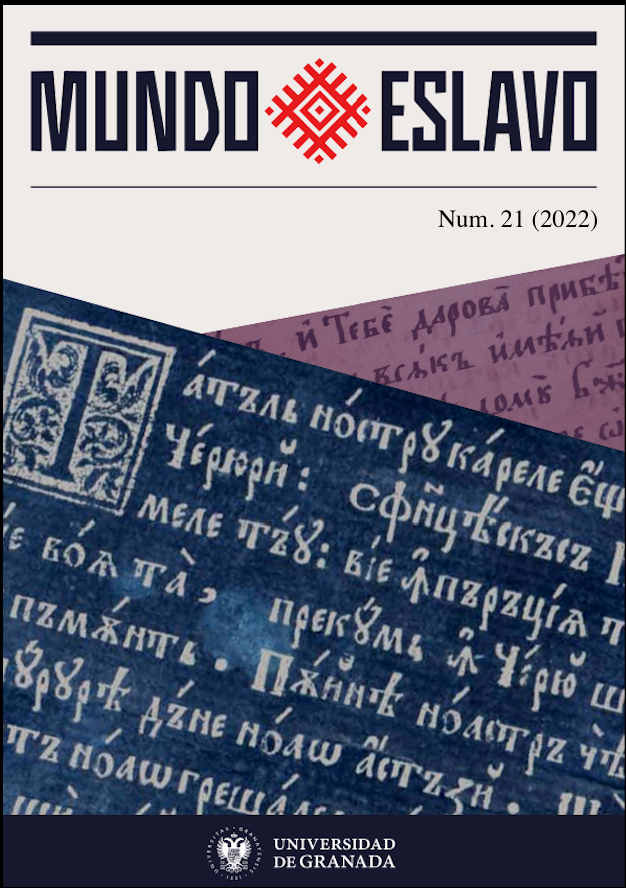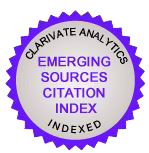Image of the Rusalkas in the literary work of M. Yu. Lermontov
DOI:
https://doi.org/10.30827/meslav.vi21.25674Abstract
The main aim of this article is to describe the genesis and prototype features of the Russian Mermaids, or rusalkas; to delve into the origin of the interest of the Russian romantic writers towards these mythological beings; and, finally, to analyze the literary features of this character in the poetry and prose of M. Yu. Lermontov. The authors highlight, on the one hand, what characteristics of the original mythological character are retained in Lermontov’s writings, and, on the other, with what specific and unique characteristics M. Yu. Lermontov, according to the conventions or literary premises of his time, enriches this mythological figure in his writings.
Downloads
References
Adzima, R. (2021). Obraz rusalki-utoplennicy v russkoj romanticheskoj literature. Novyj filologicheskij vestnik, 1 (56), 127-137.
Belova, O. V., Petruhin V. Ja. (2008). Fol’klor i knizhnost’: Mif i istoricheskie realii. Moskva: Nauka.
Berkovskij, V. G. (1958). Narodno-liricheskaja tragedija Pushkina (Rusalka). Russkaja literatura, 1, 83-112.
Cotterell, A. (2008). Diccionario de mitología universal. Madrid: Ariel.
Davidovskij, P. (1913). Genezis «Pesni o kupce Kalashnikovne». Filologicheskie zapiski, IV-V, 585-586.
Dudareva, M. A. (2018). Poiski inogo carstva v russkoj literature XIX-nachala XX veka. Fol’klornaja jestetika. Moskva-Sankt Peterburg: Nestor-Istorija.
Evgen’eva, A. P. (Gl. red.) (1984). Slovar’ russkogo jazyka v 4-h t AN SSSR, In-t rus. Jaz. t. 4. Moskva: Russkij jazyk.
Fasmer, M. (1971). Jetimologicheskij slovar’ russkogo jazyka. Moskva: Progress.
Galieva, M.A. (2015). Fol’klorizm prozy M.Ju. Lermontova: postanovka voprosa. Povest’ «Taman’». Nauka o cheloveke: gumanitarnye issledovanija, 22, 15 – 20.
Gol’denberg, A. H. (2007). Arhetipy v pojetike N. V. Gogolja. Volgograd: Nauchnoe izdatel’stvo VGSPU.
Lérmontov, M. Yu. (1990). Un héroe de nuestro tiempo. Barcelona: Planeta.
Lérmontov, M. Yu. (2014). Poemas. Poesías líricas. Madrid: Cátedra.
Levkievskaja E. E. (2010). Mify vostochnyh slavjan. Moskva: AST.
Lermontov, M. Ju. (1954). Sochinenija, t. 2. Moskva: Izdatel’stvo AN SSSR.
Lermontov, M. Ju. (1980). Mcyri. En M. Ju. Lermontov, Sobranie sochinenijv 4 t., t.2, Leningrad: Nauka.
Lermontov, M. Ju. (1981). Geroj nashego vremeni. En M. Ju. Lermontov, Sobranie sochinenij v 4 t., t. 4. Leningrad: Nauka.
Manujlov V.A. (1966). Roman M. Ju. Lermontova «Geroj nashego vremeni» (kommentarii). Moskva: Prosveshhenie.
Meletinskij. E. M. (Gl. red.) (1998). Mifologija. En Bol’shoj jenciklopedicheskij slovar’. Moskva: Bol’shaja Rossijskaja jenciklopedija.
Mendel’son, N. (1914). Narodnye motivy v pojezii Lermontova. En Venok M. Ju. Lermontova: Jubilejnyj sbornik. Moskva-Praga: Izd. T-va. V.V. Dumnov.
Modestova, V. (2007). Russkij fol’klor. Sbornik mifov, bylin, skazok, pesen, zagadok, poslovic, pogovorok. Moskva: Hudozh. literatura.
Molina-Moreno, F. (2015). Русалки в Полесье и сирены в античности. Paleoslavica, 23 (2), 197-220.
Novikova, L. S. (2020). Pereosmyslenie fol’klornogo obraza rusalki v proizvedenijah N. V. Gogolja. En S. A. Vasil’ev, Nacional’nyj stil’ russkoj literaturnoj klassiki: Materialy V Mezhduvuzovkoj s mezhdunarodnym uchastiem nauchno-prakticheskoj konferencii.Moskva: Moskovskij gorodskoj pedagogicheskij universitet.
Pomeranceva, Je. V. (1975). Mifologicheskie personazhi v russkom fol’klore. Moskva: Nauka.
Presa, F. (ed.) (1997). Historia de las literaturas eslavas. Madrid: Cátedra.
Pushkin, A. S. (1947). Polnoe sobranie sochinenij v 16 t., t. 2. Moskva-Leningrad: Izdatel’stvo AN SSSR.
Pushkin, A. S. (1948). Polnoe sobranie sochinenij v 16 t., t. 3. Moskva-Leningrad: Izdatel’stvo AN SSSR.
Pushkin, A.S. (2007). Izbrannoe. Moskva: Jeksmo.
Sánchez, M. (2003). Guía de cultura rusa. Madrid: Atenea.
Sobol, V. (2011). The Uncanny Frontier of Russian Identity: Travel, Ethnography and Empire in Lermontov ́s “Taman ́”. The Russian Review, 70, 65-79
Sokolova, L. y Guzmán, R. (2004). El folclore de los pueblos eslavos. Granada: Editorial Universidad de Granada.
Travinkov, S. N. (2019). Obraz rusalki v literature i fol’klore pushkinskogo vremeni. En Pushkinskie chtenija: Sbornik nauchnyh rabot po itogam Mezhdunarodnoj nauchno-prakticheskoj konferencii «XXVIII Pushkinskie chtenija», Moskva: Gosudarstvennyj Institut russkogo Jazyka im. A.S. Pushkina.
Umanskaja, M.M. (1971). Lermontov i romantizm ego vremeni. Jaroslavl’: Verh-Volzh. kn. Izd-vo.
Vacuro, V. Je. (2008). M. Ju. Lermontov i fol’klor. O Lermontove. Moskva. Novoe Izdatel’stvo.
Viskovatyj, P. A. (1891). Mihail Jur’evich Lermontov: zhizn’ i tvorchestvo. Moskva: Izdanie V. F. Rihtera.
Vladimirov, P.V. (1892). Istoricheskie i narodno-bytovye sjuzhety v pojezii M. Ju. Lermontov. Chtenija v Istoricheskom obshhestve Nestora Letopisca. Kiev.
Waegemans, E. (2003). Historia de la literatura rusa desde el tiempo de Pedro el Grande. Madrid: Ediciones Internacionales Universitarias.
Zaharenko, V.I. (2004). Rusalka. En I.S. Brileva, N.P. Vol’skaja, D.B. Gudkov, I.V. Zaharenko, V.V. Krasnyh (eds.), Russkoe kul’turnoe prostranstvo: Lingvokul’turologicheskij slovar’. Moskva: Gnozis.
Zgurskaja, O. G. (2014). Mifologicheskij i real’nyj mir v drame A. S. Pushkin Rusalka. Voprosy kognitivnoj lingvistiki, 22, 4 (41), 85-91.
Zelenin, D. K. (1995). Izbrannye trudy. Ocherki russkoj mifologii: umershie neestestvennoju smert’ju i rusalki. Moskva: Indrik.
Downloads
Published
How to Cite
Issue
Section
License
Copyright (c) 2022 Mundo Eslavo

This work is licensed under a Creative Commons Attribution-NonCommercial-ShareAlike 4.0 International License.

CC BY-SA: This license allows reusers to distribute, remix, adapt, and build upon the material in any medium or format, so long as attribution is given to the creator. The license allows for commercial use. If you remix, adapt, or build upon the material, you must license the modified material under identical terms.
CC BY-SA includes the following elements:
BY ![]() – Credit must be given to the creator
– Credit must be given to the creator
SA ![]() – Adaptations must be shared under the same terms
– Adaptations must be shared under the same terms
Authors who publish with this journal agree to the following terms:
1. Authors retain copyright and grant the journal right of first publication with the work simultaneously licensed under a Creative Commons Attribution License that allows others to share the work with an acknowledgement of the work's authorship and initial publication in this journal.
2. Authors are able to enter into separate, additional contractual arrangements for the non-exclusive distribution of the journal's published version of the work (e.g., post it to an institutional repository or publish it in a book), with an acknowledgement of its initial publication in this journal.
3. Authors are permitted and encouraged to post their work online (e.g., in institutional repositories or on their website) prior to and during the submission process, as it can lead to productive exchanges, as well as earlier and greater citation of published work (See The Effect of Open Access).













